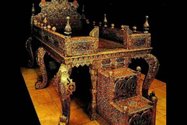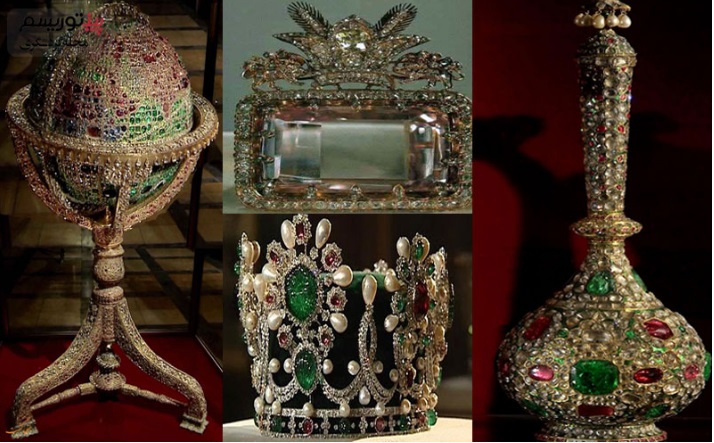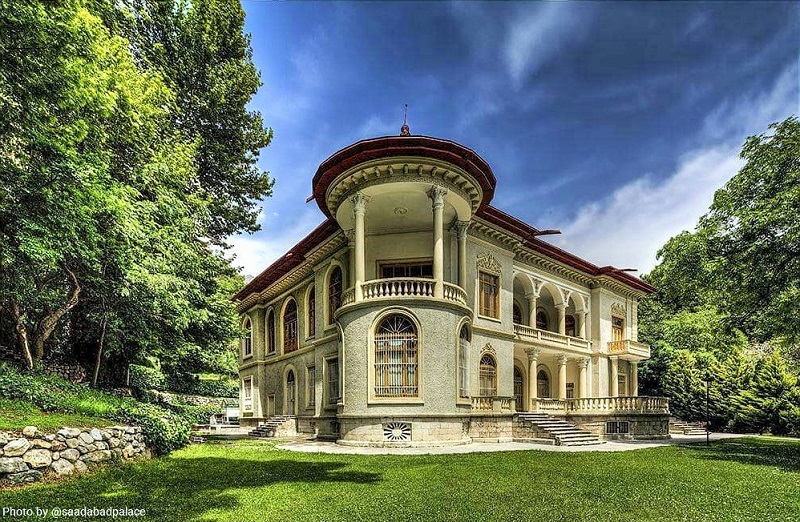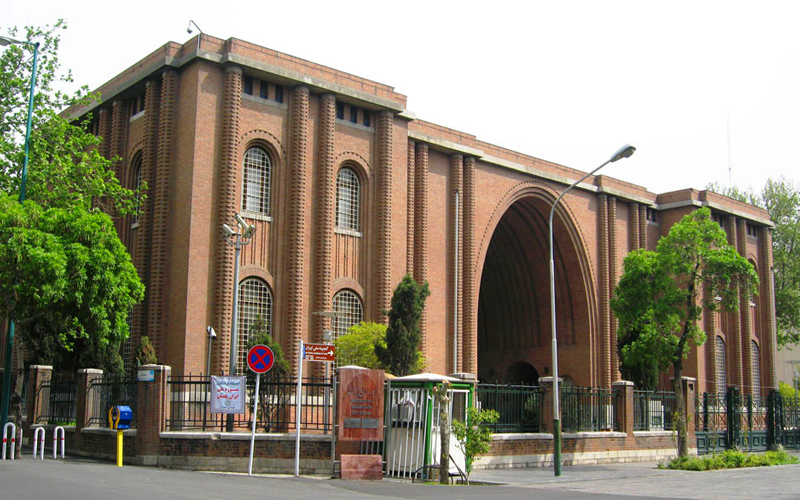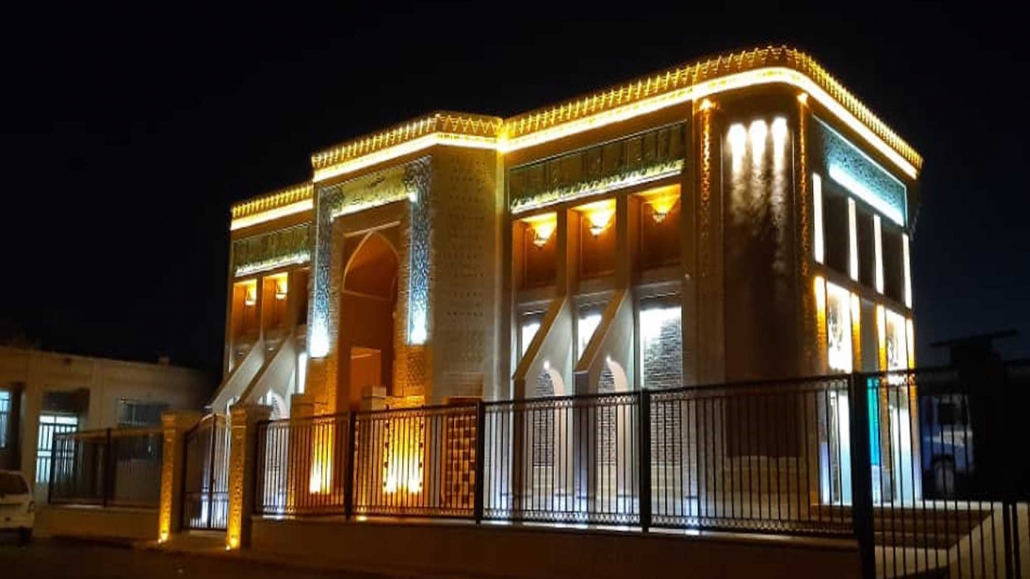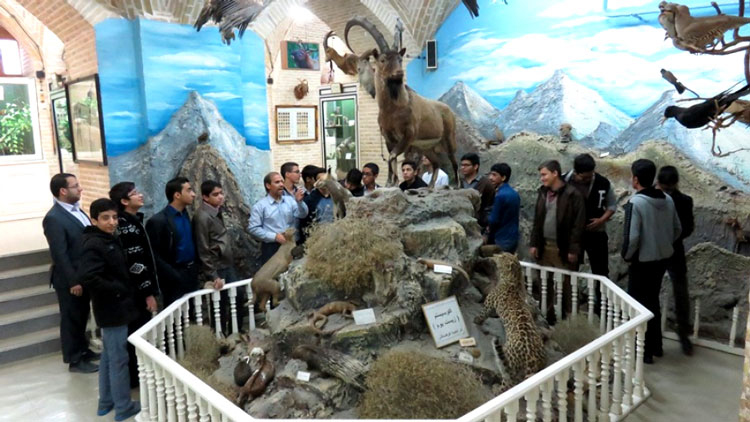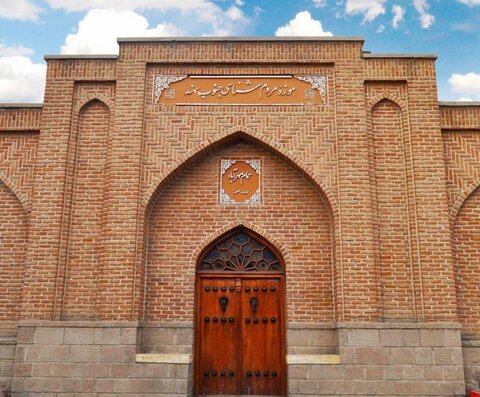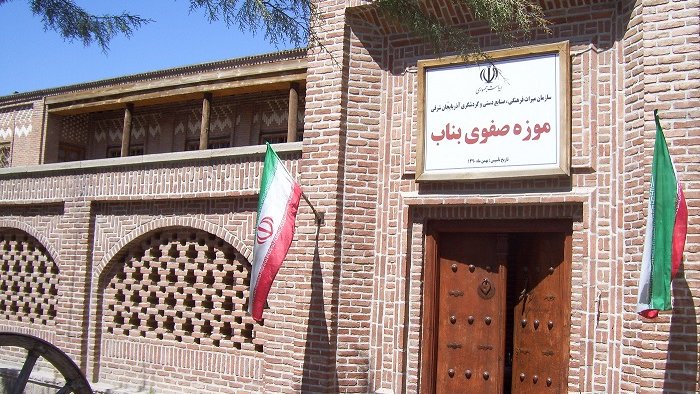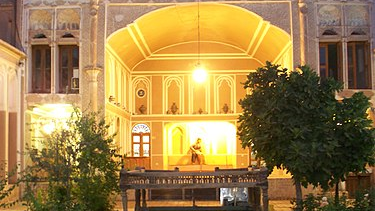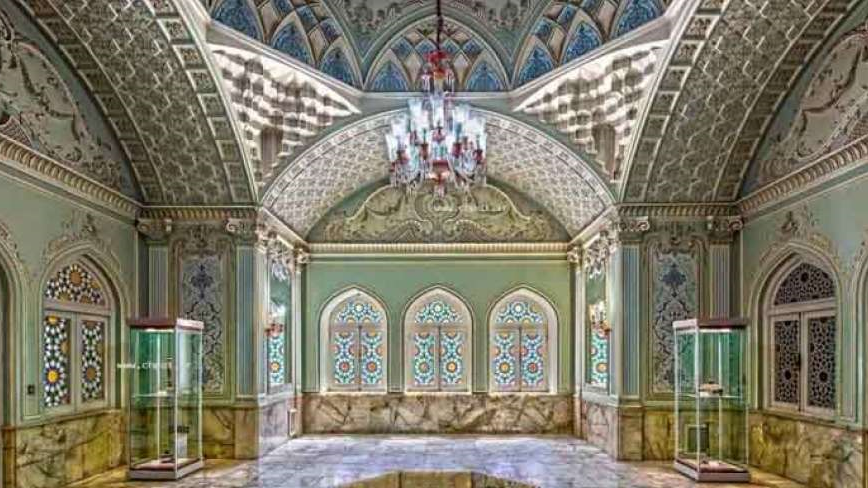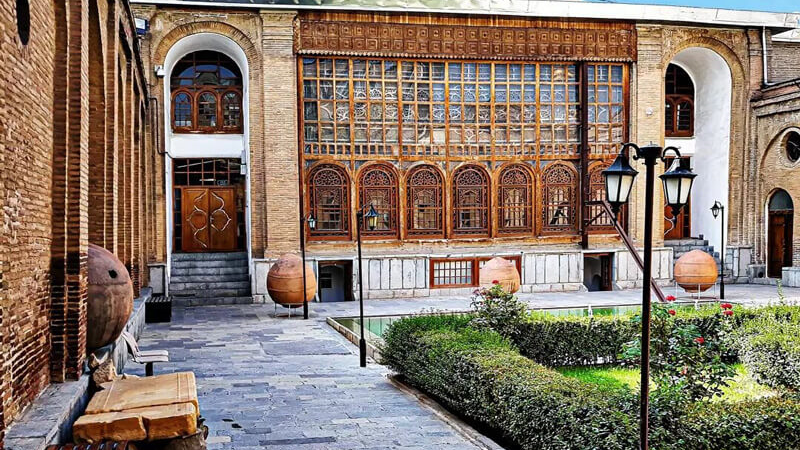The jewels and pieces in the National Jewelry Treasury are categorized into 36 cabinets. The contents of these cabinets are highly diverse and primarily include various decorative jewelry, different types of crowns and half-crowns, jeweled headpieces (Jiqah), vases, food covers, hookahs, mirrors, enamel jugs, candlesticks, turquoise items, swords, daggers, shields, clocks, inkwells, snuff boxes, ruby- and garnet-adorned objects, rifles, canes, medals, thrones, pins and brooches, pearls, and more.
Below are some of the famous pieces, accompanied by images and brief descriptions of each.
Darya-ye Noor Diamond (Sea of Light Diamond)

ChatGPT said:
This diamond may hold the highest rank among the jewels of Iran’s National Treasury. This famous diamond and the Koh-i-Noor diamond, due to the similarity in their names, have often been regarded as a pair, even though they have no similarities in cut or color. Both gems originally belonged to Nader Shah, but the Koh-i-Noor diamond was taken to Afghanistan by Ahmad Shah Durrani after Nader Shah’s death. Later, it passed to Shah Shuja, and following his defeat, it was captured by an Indian commander known as Sher Punjab. The gem eventually came into the possession of the East India Company and was subsequently sent to the British court as a gift to Queen Victoria. Today, this diamond is set in the crown of Queen Elizabeth, the mother of the current queen of England.
The Darya-ye Noor diamond, after the assassination of Nader Shah, passed to his grandson, Shahrokh Mirza. It later came into the possession of Amir Alam Khan Khezimeh and subsequently to Lotf Ali Khan Zand. When Lotf Ali Khan was defeated by Agha Mohammad Khan Qajar, the diamond was transferred to the Qajar treasury.
Naser al-Din Shah believed that this gem was one of the jewels from Cyrus the Great’s crown. He held a great fondness for this precious stone, at times adorning his hat with it and at other times wearing it on his chest. He even established a special office for the custody of the Darya-ye Noor and entrusted this important honor to the nobles and dignitaries of the country.
The Darya-ye Noor later became part of a state museum and is now one of the highlights of the National Jewels Treasury. It weighs 182 carats and has a pink color, one of the rarest hues for a diamond.
In 1965 (1344 SH), during an examination of the National Jewels by Canadian experts, a very interesting detail about this gem was discovered:
Tavernier, the famous French traveler and gemologist, mentioned a 242-carat pink diamond in his book, noting that he saw it in the East in 1642 CE. He also included a diagram and measurements of the diamond, referring to it as the Grand Table Diamante (the Large Table Diamond).
The color and shape of this diamond caught the attention of the Canadian experts, who concluded that the Darya-ye Noor and Nur al-Ain were originally a single diamond that was later split into two pieces. The larger piece became known as Darya-ye Noor, while the smaller piece, weighing 60 carats, is called Nur al-Ain and is currently set in the center of Tiara No. 2, located in Treasury Chest 26.
Pahlavi Crown
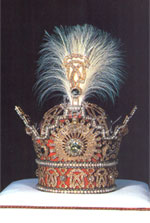
The crown used by Reza Shah and Mohammad Reza Pahlavi was crafted from gold and silver and adorned with exquisite diamonds, large emeralds, sapphires, and pearls. The cap of the crown is covered with red velvet, and atop its dome sits a cabochon emerald set in a claw mount.
The crown features four stepped crenellations on each side, inspired by the crowns of Sassanid emperors. At the center, beneath the front crenellation, is a golden sun with diamond-studded rays and a large yellow diamond at its center. Behind this crenellation is a base-mounted jqqeh in the eslimi design, and behind that, a plume of ostrich feathers.
The number of gemstones set on the crown is as follows: 3,380 diamonds weighing 1,144 carats, 5 emeralds totaling 199 carats, 2 sapphires weighing 19 carats, and 368 pearls. The combined weight of the gold, gemstones, and velvet amounts to 444 mesghal, approximately 2.8 kilograms.
Previously, the Kiani Crown was used in coronations during the Qajar era. However, Reza Shah preferred not to use it for his own coronation. Therefore, in 1304 SH (1925 CE), a team of Iranian jewelers under the supervision of Serajeddin Javaheri—a renowned Caucasian jeweler who had migrated from Russia to Iran and was also the jeweler of the Emir of Bukhara—crafted a new crown using selected gemstones. This crown was subsequently used by Reza Shah and Mohammad Reza Pahlavi in their coronation ceremonies.
Naderi Jiqah
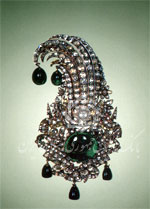
ChatGPT said:
The Naderi Jiqah is adorned with diamonds and emeralds, featuring a large, beautifully colored cabochon emerald set at its center. Beneath the jiqah, three pendants of vivid emeralds hang gracefully. The upper part of the jiqah consists of seven segments, with two garlands of diamond-studded leaves and flowers on each side. From the tips of the segments, two high-quality Saidi emerald pendants are suspended. Above the central emerald sits a diamond-encrusted crescent, while at the bottom on either side, miniature representations of a banner, drum, cannon tube, and spear are attached to the band. The fabric of the banner is divided into three rows of rubies, diamonds, and light emeralds. The entire jiqah is decorated with fine and large, high-quality diamonds. Reza Shah Pahlavi occasionally wore this jiqah. Its weight is 33 mithqals and 16 nokods.
(Produced in Iran, 12th century AH)
Kiani Crown
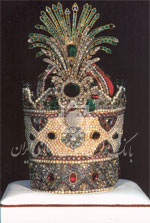
The Fath-Ali Shah Crown, also known as the Kiani Crown, is adorned with diamonds, emeralds, rubies, and pearls. It was crafted during the reign of Fath-Ali Shah and was used by the Qajar monarchs. This crown is notable as the first crown made in this style since the Sassanian era.
(Made in Iran, 1212 AH / early 19th century CE)
Jeweled Globe
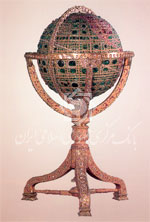
This globe (ornamental sphere) was crafted in 1291 AH (1874–1875 CE) by order of Naser al-Din Shah, executed by a group of Iranian jewelers led by Ebrahim Masihi, using jewels from the treasury. The pure gold used in the globe weighs 34 kilograms, and the weight of the embedded gemstones totals 3,656 grams. The globe is adorned with 51,366 individual gemstones.
Identifying the countries amid the sparkling jewels is challenging, as the jeweler’s skill in craftsmanship seems to have outweighed strict adherence to cartographic accuracy. The seas are represented with emeralds, and the landmasses with rubies. Southeast Asia, Iran, and England are highlighted with diamonds; India with light-colored rubies; and Central and South Africa with sapphires. The equator and other geographic lines are also marked with diamonds. The diameter of the globe is approximately two feet (66 centimeters), and it rests on a base entirely made of gold and adorned with gemstones.
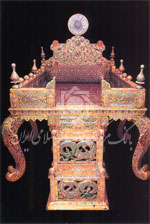
Peacock Throne (Takhte Tavous / Takht-e Khorshid)
By order of Fath-Ali Shah in 1216 AH (1801–1802 CE), a grand and magnificent throne was constructed under the supervision of Nezam al-Dowleh, Mohammad Hossein Khan Sadr Esfahani, the governor of Isfahan, using the jewels and gold from the royal treasury. Originally named Takht-e Khorshid (Throne of the Sun) due to the jeweled sun motif at its top, it retained this name for several years.
After Fath-Ali Shah married Taj al-Dowleh (nicknamed Tavous Khanum), the throne became popularly known as Takht-e Tavous (Peacock Throne) in her honor. Some Iranians mistakenly believed this throne was the same as the famed Peacock Throne of India. However, by comparing descriptions by the French traveler Jean-Baptiste Tavernier with the existing throne, and consulting Naser al-Din Shah, it was confirmed that this throne had indeed been made by Fath-Ali Shah and named after his wife.
Years later, during Naser al-Din Shah’s reign, who paid special attention to royal jewels and treasures, the throne underwent repairs and minor modifications. Inscriptions recording the restoration, written in beautiful Nasta’liq script on a gold background with lapis lazuli enamel, were added around the throne in separate couplets. These inscriptions are now installed in sequence, reflecting the later restoration.
The throne remained in the Golestan Palace Hall until 1360 SH (1981–1982 CE) when it was transferred to the National Jewels Treasury of the Central Bank of the Islamic Republic of Iran, ensuring its preservation alongside other treasury jewels, in accordance with the 1316 SH law.
